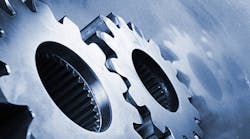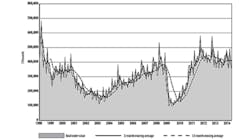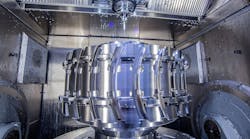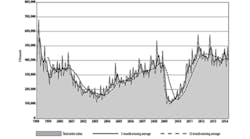“Manufacturing technology” — as the machine tool industry prefers to be known — is difficult to define as an industrial sector: It involves much more than machine builders and distributors, job shops (machining operations), and component parts producers within larger organizations. Purchases of CNC machines and cutting tools are one indicator of the market’s economics, but how should we evaluate for other critical factors, like purchases of raw material, software and automation, and auxiliary technologies and services.
In any case, as an industrial “sector,” manufacturing technology has its hooks into various other sectors, including automaking, aerospace manufacturing, energy, and high-tech manufacturing, just to list a few, meaning the machining sector’s fortunes are tied to activity in those areas.
The ways that manufacturing organizations strategize their expansion plans is the tip-off to their economic prospects: in recent months, mergers and acquisitions (M&A) are the proof of their progress.
While demand for machine tools and cutting tools has been tepid for most of the past year, there is one indicator suggesting long-term growth for manufacturing technology: mergers and acquisitions. A series of acquisitions by companies in different niches of manufacturing technology suggests smart money wants a share of this sector’s future.
A Quarter Full of Expansion
For example, GF Machining Solutions agreed to buy Liechti Engineering AG, a Swiss specialty manufacture of five-axis CNC milling machines for aircraft engine and IGT blades and blisks. It counts as a brand extension for GF Machining, which is a well-known designer/builder of machines for high-speed milling, wire EDM, die-sinking EDM, and such precision processes.
The value of the purchase is not known, but GF indicated Liechti Engineering would strengthen its presence in the expanding aerospace market.
“Liechti Engineering AG brings a wealth of know-how and a well-established reputation for high performance and superior service for its customers,” according to Yves Serra, CEO of GF. “Together, the two companies offer a wide array of technologies for the production of aircraft engine parts as well as a worldwide sales and service organization to support its customers.”
Mergers are not just for machines: Apex Tool Group acquire cutting tool manufacturer Niagara Tools, making it part of Apex’s Power and Professional Tools business unit. The latter supplies North American automotive and aerospace manufacturers with precision tooling, cutting, and grinding products and technologies.
Again, the value of the acquisition was not revealed.
"Strategic Complements" All Around
“Niagara Tools is a strong strategic complement to our Power Tools business,” said Steve Breitzka, President and CEO of Apex. “This acquisition allows Niagara to leverage our global MVI, aerospace, and industrial relationships to expand its channels, and it offers Apex significant cross-selling opportunities within Niagara’s customer base.”
There is a future in control and program technology too: Hexagon AB, a portfolio of design, measurement and visualisation technology products, acquired Vero Software, a CAM program developer.
Vero Software is a platform of programming and control software with a strong focus on design and manufacturing processes. Among its software brands are Alphacam, Cabinet Vision, Edgecam, Radan, SurfCAM, VISI, and WorkNC. Hexagon stated the acquisition strengthens its own software offerings, and helps to “close the gap of making quality data fully actionable by extending the reach of the newly developed MMS (metrology planning software) to include CAM (manufacturing planning software.)”
“Together with its unique suite of manufacturing software solutions, Vero Software has the expertise, knowledge and resources to deliver even higher levels of productivity to our customers,” stated Hexagon president and CEO Ola Rollén. “Leveraging our global footprint, the synergies from our combined technologies will advance our strategy, supporting the growing need to integrate all data and processes across the manufacturing lifecycle.”
Still another example growth by acquisition is gearmaking specialist Gleason buying Distech Systems Inc., a Rochester, N.Y., designer and manufacturer of factory automation systems.
“Gleason and Distech have successfully collaborated on many projects over the past several years,” according to Distech president Daniel J. Schwab, “allowing both companies to become very familiar with each other’s products, services and strengths. Our company has experienced significant growth recently and Gleason is the ideal partner to help in sustaining that growth. Gleason’s market reach and technical and operational competencies will be important assets in our future success.”
Discounting evidence of economic growth because of uncertain demand for machine tools and cutting tools overlooks the more salient fact about manufacturing technology: it transcends all sectors and draws its potential from the overall expansion of manufacturing. There, the evidence of expansion based on M&A activity is more obvious, with examples like General Electric’s pursuit of Alstom, among others.
Merger and acquisition deal activity increased markedly across the global industrial products sector during Q2 2014, according to a report by PricewaterhouseCoopers LLP, with a significant rise in both deal volume and value across on both the quarter-to-quarter and year-over-year basis.
"As the global economy recovers and the competitive environment intensifies, we are seeing a widespread increase in M&A activity, including a more confident base of business leaders taking a risk-tolerant approach to deal-making," observed PwC’s Robert McCutcheon, U.S. industrial products leader.
"While the M&A market continues to be driven primarily by local deals aimed at strengthening core products and services, we are beginning to witness a rebound in cross-border activity as acquirers search for opportunities in faster-growing, but more volatile markets,” he said.










